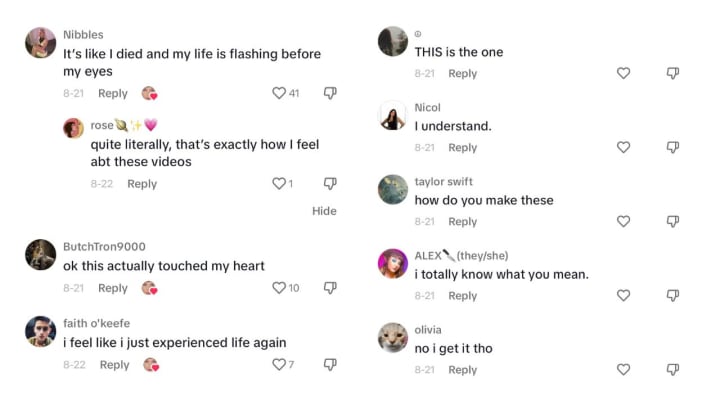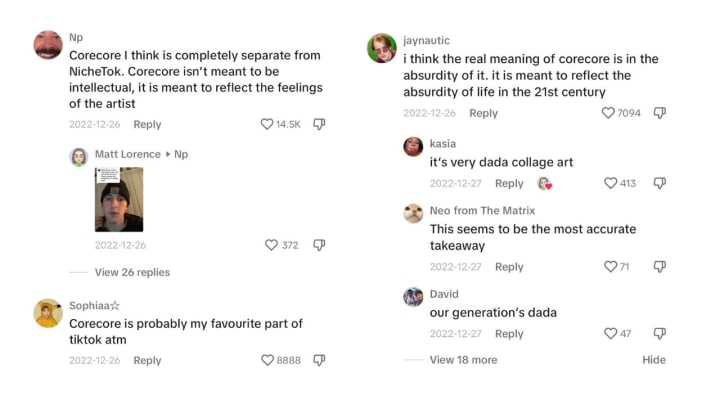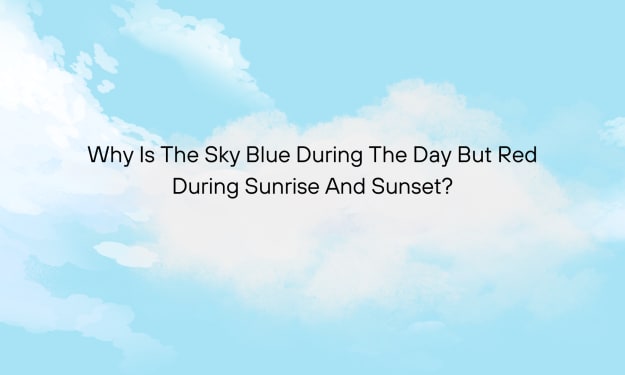
Between flashes of viral memes, feature films, YouTube videos, and old Goldfish commercials (?) emerges TikTok's latest diverting trend: corecore.
A true menagerie of pop culture, #corecore has garnered over 6 billion views since gaining significant traction in early 2023. Initially presenting as video montages with political undertones, TikTok's so-called "anti-trend" has spent the last six months shapeshifting, seemingly unsure of how to live up to its meta name.
Unlike all of its '-core' predecessors (#cottagecore, #barbiecore), this hashtag hasn't peaked and disappeared in a few short weeks, making it a prime outlier in the rinse-and-repeat viral video pattern.
By tracing the evolution of corecore, we gain rather jarring insight into the current state of the Internet - where social networking has all but fizzled out under our noses and replaced by content-sharing goliaths.
Corecore 101
The genesis of the corecore hashtag on TikTok stems back to the summer of 2022. Though, according to Know Your Meme, the term itself first appeared on Tumblr circa 2020.
In part, corecore can be conceived as a video editing style - one that is certainly not new to the TikTok platform, nor the Internet as a whole. Montages and meme compilations have long been the bread and butter of social media entertainment. So what exactly sets corecore apart?
Truth be told, not much. Corecore, in many ways, appears to simply follow the current course of modern media oversaturation. Yet, this dizzying content trend has become an oddly comforting break from the daily doomscroll as of late.
In August 2023, viral corecore videos, set to upbeat tracks, sparked a sort of joyous, communal understanding and nostalgia. Indeed, without words or context, creators were able to generate a nearly inexplicable feeling of human connection through a mishmash of seemingly random clips.

In the TikTok age, this reflects the holy grail for Internet aesthetics: the ability to feel seen or understood. Since the depths of the pandemic, the dissemination of hyper-specified videos via TikTok algorithms has allowed users to feel connected with others without ever striking up an actual conversation.
TikTok creator Matt Lorence sums up this phenomenon as "aesthetic catharsis." He also argues that it comes at a cost.
The Allure of TikTok Aesthetics
Gen Z comes to TikTok for an immersive, personalized, and authentic social media experience held together by the prevalence of niche communities.
From dark academia to Y2K, the demographic's infatuation with TikTok aesthetics (or subcultures) has created a space where young people feel more comfortable directly expressing and embodying their fluctuating interests.
This digital landscape of shared passion and creativity is overwhelmingly visual, and, to some critics, leans heavily toward obscurity, romanticization, and unreality. In other terms, Gen Z is often affiliated with not being able to take anything seriously - skirting the real world at every corner with Internet quips.
Take the heated TikTok Congressional hearing earlier this year, which was promptly followed by thirst trap fan edits of CEO, Shou Zi Chew.
Punchy, trend-affirming responses like these have, no doubt, made the app an entertaining place to be. Yet, as regards content creation patterns, Gen Z has arguably captained us into an era that frequently trades intellectual engagement for escapism.
Matt Lorence credits this phenomenon for the obfuscation of corecore over the last year. Further, he suggests that the video collage format becomes emptied of its mobilizing power and meaning when removed from an ideological foundation (such as corecore's environmentalist and anti-capitalist roots).
Here we see a split in opinion emerge about what the overarching purpose of corecore should be in the long run. In the comment section of Lorence's video, there are mixed reactions and interpretations of the trend as both an Internet aesthetic and a potential art movement.

Indeed, as corecore has fragmented into other #NicheTok trends, it's become increasingly difficult to categorize, let alone define.
In theory, corecore should be at its most authentic when it remains elusive, absurd, and scattered. So much so, that some would argue that the true essence of corecore is tied to a resurgence of Dada art.
21st Century Dadaism?
For those unfamiliar, Dada was an artistic and literary movement that arose in response to the horrors of World War I. Debuting in Zurich, Switzerland, Dada was deeply experimental and diverse in its manifestations - from performance art to sculpture to collage.
Above all, Dada's nihilistic backbone cemented the movement as distinctly anti-aesthetic or anti-art. Dadaists rejected conformity on all fronts and grappled playfully, often satirically, with the absurdity of human existence, connection, and culture.
Per IdeelArt Magazine, the Dadaist aspiration of "communicating feeling through abstraction" brings humanity closer to the true meaning and value of art which supersedes logic or categorization.
Comparably, corecore's evolution, sprung from the social upheaval of a deadly global pandemic, reflects the Dadaist pattern of reacting to an era's disorienting challenges with creative rebellion of indefinite meaning.
If we continue to take a page out of the Dadaist handbook to analyze this TikTok phenomenon, the concern for corecore to maintain an intellectual core (for lack of a better word), appears misplaced. Dada's immense impact on surrealist art and postmodern thought has proven that an (anti)art movement can generate power and meaning without clinging to a discrete philosophical or ideological intention.
Along these lines, 19-year-old corecore creator Eddie Hewer offers a helpful middle ground in the intellectualizing v. abstracting corecore debate, commenting that the video-editing phenomenon is "a vessel for young artists to experiment with before stepping out into the broader world of art."

Of course, the irony of the digital medium is not lost on creators like Hewer, who readily points out that corecore thrives in and actively reinforces an Internet echo chamber.
Reacting to media overstimulation by compiling, recycling, and commoditizing content only adds to the deafening roar of late-stage capitalism that corecore originally set out to criticize. Thus, the paradox of the "anti-trend" is inevitable. Both refreshing and exhausting, assuring and bleak, corecore and its concurrent offshoots (#hopecore, #mecore) embody the troubling space where hyperconnectivity meets seclusion.
All in all, since corecore is still actively progressing and perhaps abating, there is an understandable reluctance to officially deem it an artistic or cultural movement. However, the sprawling online phenomenon, at the very least, calls into question how we create, define, and share art in the post-2020 era.
Digital Overwhelm and Disconnection
In the words of early corecore creator, @heksensabbat, the motive behind this controversial and often confusing trend is simply "to convey some sort of emotion to the viewer." For younger demographics primarily engaging with this type of content (81% of corecore viewers are aged 18-24) the emotions caught up in these video collages are strong and truly run the gamut.
From the trite motivational intensity of #hopecore to the comedic display of visual identity seen in #mecore, the ever-revolving relatable entertainment feed absorbed and largely controlled by Gen Z is a seemingly unstoppable force in pop culture. It's also a clarifying reminder of the current state of digital connection built around a superfluity of content with little to no focus on finding and maintaining friendships.
In a striking piece for The Atlantic, author and video game designer Ian Bogost relates this phenomenon to a broader, ongoing schism between social media and social networking. The latter, Bogost argues, has become completely reinterpreted in the TikTok era. That is, today's digital networks have now become primarily “a channel through which to broadcast."
The advent of TikTok influencers and parasocial relationships has rounded out this new age of connection where content creation reigns supreme and any networking that does occur remains widely impersonal. In other words, the "social" in social media is being drowned out by the unfettered expansion of entertainment apps, which have reshaped marketing techniques, the music industry, and human connection as a whole.
With social media coasting on a constant cycle of Internet fads, corecore's endurance as a TikTok aesthetic indicates that it's not just another product of passive consumption.
By condensing the relentless scroll of juxtaposing content that we’ve all imperceptibly grown accustomed to in recent years, corecore attempts to bridge the gap of online engagement with a glimmer of shared context and meaning - a chord of universality in the modern human experience. It calls out our loneliness and seclusion while providing a flashy, temporary antidote.
"I Love I Get To Exist With You Guys"
Though there's been a flurry of headlines about social media being doomed to die, corecore nudges us toward a more heartfelt yet equally pertinent discourse about meeting the frustration and absurdity of existence on the Internet head-on. To quote VICE News' apt description of the phenomena: “corecore is the screaming-into-void TikTok trend we deserve.”
Preceding the surge of summer corecore videos screaming into said void, a perplexingly beautiful parallel trend called the Pinegrove Shuffle arose. This simple little dance step set to the beat of Pinegrove's song "Need 2" brought the TikTok community together for a pleasant moment of respite and mutual unornamented bliss.
Per the corecore editing custom, TikTok user Jacob Hogue compiled some of the countless videos posted of strangers doing the catchy shuffle, captioning the post: "I love I get to exist with you guys."
The video got over 1.5 million likes and the resultant comment section reflected a similar heartwarming tone and sentiment to other trending corecore videos of summer 2023.

These assuring pivots away from corecore's darker subsets (which tend to feed off of a victim mentality and isolation), remind us that TikTok's overwhelming power to generate communal appreciation can still be harnessed for inspiring outcomes.
Thus, even in an Internet landscape ripe with main character syndrome, corecore continues to bring us together, albeit as strangers, through vague glimmers of joy with doomsday undertones. What better way to relish the beauty and terror of the digital age?
About the Creator
Erin Shea
New Englander
Grad Student
Living with Lupus and POTS
Instagram: @somebookishrambles






Comments (1)
Great work! Wonderful!